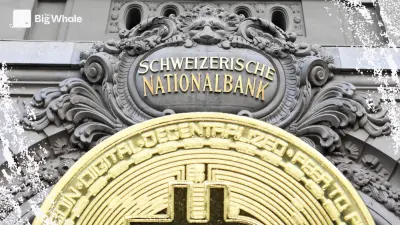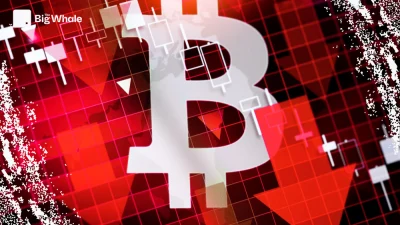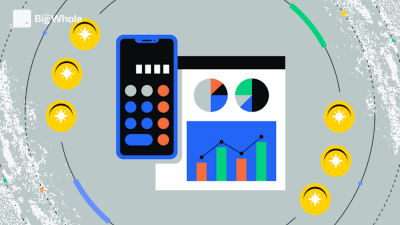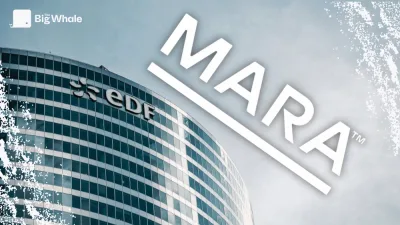TBW - Cardano (ADA): Analysis of a project in search of adoption

What you need to know
Created in 2015 and operational since 2017, Cardano represents a new generation of blockchain based on a proof-of-stake (PoS) protocol. The project stands out for its methodical approach, drawing on academic research and rigorous validation protocols. This platform provides concrete solutions to the challenges faced by its predecessors, particularly in terms of processing capacity and energy consumption. Despite the favourable positioning of ADA, its cryptocurrency, which occupies 9th place on the market in terms of capitalisation, the network is still struggling to generate a volume of activity comparable to its main competitors.
General presentation
Cardano represents a next-generation blockchain developed using a rigorous scientific methodology. Launched in 2017 by IOHK under the leadership of former Ethereum co-founder Charles Hoskinson, the platform aims to solve the technical challenges faced by its predecessors.
The project's governance is based around three distinct organisations:
- The Cardano Foundation, responsible for general oversight and regulatory matters
- IOHK, which drives technical development and research
- EMURGO, responsible for business development and partnerships
Cardano's architecture is based on two components:
- A settlement layer (CSL) dedicated to transactions
- A computation layer (CCL) managing smart contracts via the Plutus language
The Ouroboros consensus protocol, based on proof of stake, enables transactions to be validated in a decentralised way while limiting energy consumption.
The platform offers functionalities for decentralised applications and DeFi finance. It is also developing digital identity and traceability solutions, particularly in emerging markets.
The ADA token powers the ecosystem and enables users to participate in the governance and security of the network via staking. Development follows a five-stage plan to improve performance and adoption.
Despite a methodical, research-led approach, Cardano remains a development project that has yet to prove itself against established blockchains.
Funding
The Cardano project was primarily funded through an initial coin offering (ICO) conducted between September 2015 and January 2017. During this period, approximately 25.9 billion ADA tokens were sold, representing approximately 57.6% of the total offering of 45 billion tokens. The ICO raised approximately $62.2 million, with an average price of $0.0024 per ADA . 
Unlike many other blockchain projects, Cardano did not seek funding from venture capitalists (VCs).
The funds raised in the ICO were sufficient to finance the initial development of the project. In addition, Charles Hoskinson, co-founder of Ethereum and founder of Cardano, personally contributed to the funding via his company IOHK (Input Output Hong Kong).
Team & Community
Charles Hoskinson, former co-founder of Ethereum (2013-2014), now runs IOHK (Input Output Hong Kong). After leaving Ethereum following strategic differences, he set up this company specialising in blockchain technology. In 2017, IOHK launched Cardano, a blockchain with a focus on security and scalability.
>> Charles Hoskinson: "Ethereum refuses on-chain governance, it's not a healthy situation"
Jeremy Wood, who also worked at Ethereum as head of operations, co-founded IOHK with Hoskinson in 2015. He left the company in 2018, but his impact remains visible in the strategic direction of Input Output Global (IOG), the entity developing Cardano.
The Cardano Foundation, led by Frederik Gregaard alongside Andreas Pletscher, Giorgio Zinetti and Nicolas Jacquemart, promotes and educates around the project.
The Cardano ecosystem relies on several collaboration platforms:
- A [GitHub directory](https://github./cardano-community) which centralises the community's open-source projects.
- The Cardano Forum, a space for technical and strategic exchange for project members.
- A notable presence on social networks, including r/CardanoDevelopers for developers and 1.4 million subscribers on X.
Functioning
Cardano deploys a transaction validation system based on proof of stake, called Ouroboros. This approach differs from the proof-of-work mechanism used by Bitcoin in its low energy consumption.
ADA token holders participate in securing the network by entrusting their tokens to validation pools.
Cardano's infrastructure is organised according to a precise time structure: 5-day epochs, divided into one-second slots. A new block of transactions can be inserted into each slot. The network appoints validators, known as Slot Leaders, on the basis of a system of drawing lots weighted by the quantity of ADA held or delegated.
These Slot Leaders validate transactions during their allocated slots. If a validator fails to act, the slot remains empty until the next slot.
This protocol guarantees the security of exchanges while limiting energy consumption. Validators are selected transparently, based on ADA holdings.
Cardano's reward system relies on two sources of funding: transaction fees and a portion of ADA reserves. These resources feed a common fund, split 80% for staking participants and 20% for project development.
To meet performance challenges, Cardano is developing Hydra, a second-layer solution enabling the simultaneous processing of multiple transactions via parallel channels.
The network uses Plutus as its native programming language, an alternative to Ethereum's Solidity which presents some technical difficulties for novice developers.
Ecosystem
Cardano's DeFi ecosystem remains under development. Minswap, the network's main decentralised exchange, has reached $3 billion in cumulative trading volume, with a locked-in value of $83 million.
Despite an experienced development team, decentralised finance applications on Cardano remain limited. Instead, the network is banking on institutional partnerships in various sectors.
In telecommunications, Dish Network has been working with Cardano since 2021 to integrate digital identity solutions. New Balance has been using Cardano technology since 2019 to authenticate its products.
The education sector is a major area of development. In April 2021, IOHK is partnering with the Ethiopian Ministry of Education to manage the school records of 5 million pupils. The Georgian Ministry of Education is also adopting Cardano technology to verify diplomas.
Academic research has not been left behind. The University of Edinburgh's Blockchain Technology Laboratory, established in 2017, and the University of Tbilisi in Georgia are collaborating with Cardano on certification projects.
These partnerships demonstrate Cardano's focus on practical applications, particularly in education and public administration.
The ADA token
ADA, Cardano's digital currency, pays tribute to Ada Lovelace, a pioneer in computer programming. This cryptocurrency is used to pay transaction fees on the network.
The market currently has 36 billion ADA tokens in circulation. The market capitalisation reaches $22 billion at the end of April 2025, for a fully diluted valuation of $28 billion. The maximum offering is capped at 45 billion tokens.
The issuance mechanism is based on staking rewards. Inflation has fallen gradually, from 3.4% in 2022-2023 to 2.3% in 2023-2024. It is now between 2% and 4% per year.
Network validators receive rewards from the ADA pool and transaction fees. Per 5-day cycle, up to 0.3% of the reserve can be distributed, but this rate generally stabilises around 0.22%, depending on network activity.
The gradual reduction in the ADA reserve will lead to lower inflation. The network is ultimately aiming for funding based on transaction fees rather than the issuance of new tokens.
At launch, Cardano put 25.927 billion ADA tokens into circulation, sold at $0.0024 between September 2015 and January 2017:
- Public sale: Distribution of a portion of the tokens via an initial sale.
- Distribution to the founding entities: IOHK (2.46 billion ADA), Emurgo (2.07 billion) and the Cardano Foundation (640 million). The tokens were immediately available.
Investors received their tokens without a lock-in period.
ADA holders can now participate in staking to earn an annual return of 2.4%. The token is used for transactions and will give access to the network's governance.
Governance
Cardano's governance has evolved significantly since its creation in 2017. Initially under the control of IOHK, the Cardano Foundation and EMURGO, the project initially aimed to establish a solid infrastructure.
The Shelley Phase, launched in 2020, introduced staking and a network of validators, while the Voltaire Phase provides for an autonomous voting and funding system.
Between 2021 and 2025, the network gradually moved towards greater decentralisation. A major turning point came on 29 January 2025 with the Plomin hard fork, giving ADA holders direct voting rights.
The current governance system is based on three pillars: the DReps (delegated representatives), the SPOs (staking pool operators) and the Constitutional Committee. The DReps, the largest of which manages 405 million ADAs, vote on changes to the protocol, treasury management and major updates.
The SPOs, responsible for validating transactions and managing the staking pools, also participate in governance decisions. The Constitutional Committee, a provisional structure, ensures compliance with the network's fundamental rules.
Although the system generally requires the approval of at least two groups for any major decision, the presence of the Constitutional Committee indicates that decentralisation is not yet complete. Coincarp data reveals notable concentration: the top 100 wallets hold 22% of ADAs in circulation.
Treasury and financial health
Cardano's treasury operates on a 5-day cycle, during which 20% of rewards are collected. These revenues come from two main sources:
- Programmed issuance, representing 0.3% of the ADA reserve
- Network transaction fees
The treasury currently holds 1.7 billion ADAs, equivalent to $1.2 billion. This reserve, exclusively in ADA, establishes a price-to-book ratio of 21.4. This figure indicates that the market valuation represents 21.4 times the value of the assets.
In terms of comparison, Ethereum maintains a cash position of $500 million, mainly in ETH, with a price-to-book ratio of 488.
Financial data reveals that stablecoins on Cardano total $25 million. This is still a modest amount compared with Ethereum ($124 billion) and Solana ($12.4 billion).
.png)
According to Artemis, fee revenue has reached $25 million since the network's inception. In perspective, Ethereum and Solana have generated $20 billion and $2 billion respectively.
The P/E ratio (a financial indicator commonly used to evaluate traditional companies) stands at 5,000 for 2025 and 5,400 for 2024, reflecting limited revenues relative to its capitalisation. This is due to a combination of low transaction fees and moderate network usage.
Business model
Cardano's business model is based on a system of ADA transaction fees. The fees are split between two main players:
- Validators, who are responsible for securing the network
- The project development fund
The modest transaction fees of around 0.17 ADA limit the network's revenues. The treasury, fed by these fees and staking rewards, funds projects approved by the community via the Catalyst programme.
Staking represents a significant part of the ecosystem with 22 billion ADA committed. As an example, an investment of 1,000 ADA generates an annual return of 25.3 ADA, or $18 at the current price.
Competitors
Cardano faces direct competition from other blockchains using the proof-of-stake mechanism and offering smart contracts. Ethereum, with its second-layer solutions, Solana and Aptos are among its rivals.
The figures speak for themselves: the total value locked up on Cardano reaches $346 million, while Ethereum and Solana record $46.5 billion and $7 billion respectively. According to DefiLlama, Cardano ranks 19th among crypto blockchains. This position is also reflected in its transaction volume.
The network shows moderate activity, a notable finding for a blockchain of this age.
gt>> Fundamental analysis of Ethereum
>> Solana's fundamental analysis
Regulation
In 2023, the Securities and Exchange Commission (SEC) classified ADA as an unregistered financial security during the Binance prosecution. This resulted in the temporary removal of ADA from several platforms, including Robinhood.
Input Output Global (IOG) objected to this classification, arguing that ADA does not meet the definition of a security.
The regulatory environment has changed with the Trump administration. In February 2025, the President spoke of a proposed Strategic Cryptocurrency Reserve for the United States, incorporating ADA as one of the selected digital assets.
This proposal, although not finalised, illustrates the significant change in the regulatory environment for Cardano.
Risks and limitations
- Slow development: The project is experiencing delays in the roll-out of key functionality. Plutus smart contracts, expected in 2018, were not launched until 2021.
- Network performance: The blockchain processes around 2 transactions per second. The Hydra protocol is being developed to resolve this limitation.
- Governance structure: Decisions remain influenced by three main organisations: IOHK, EMURGO and the Cardano Foundation.
- Application ecosystem: The number of decentralised applications in operation remains below competing networks such as Ethereum.
- Communication between blockchains: The network is struggling to establish connections with other protocols, unlike Polkadot or Cosmos.
- Network reliability: During periods of high activity, transactions become more expensive and the network shows signs of slowing down.
Roadmap
Cardano's roadmap is built around five main development phases:
- Byron: This initial phase established the basic network infrastructure and introduced the Daedalus and Yoroi digital wallets.
- Shelley: This phase marked the move towards decentralisation, allowing the community to participate in the validation of transactions.
- Goguen: The introduction of smart contracts paved the way for decentralised applications.
- Basho: This phase focused on optimising network performance.
- Voltaire: The development of a governance system allows users to vote on the evolution of the protocol.
These different phases are being rolled out gradually, with developments being carried out in parallel to ensure the continuity of the network.
For 2025, Cardano is focusing on improving performance. The Leios update targets Layer 1 optimisation, while Layer 2 solutions such as Hydra and Midgard aim to reduce network congestion.
The protocol is also looking to speed up transaction finality. Some developers are expressing reservations about the increasing technical complexity of the network, particularly for staking operators. The project plans to extend the functionality of digital assets and facilitate the work of developers, despite criticism of the pace of its development.
Where to buy ADA?
Investors can acquire ADA tokens on the main centralised exchange platforms such as Kraken, Coinbase, OKX and Binance.
The Big Whale's opinion 🐳
Cardano represents a special case in the world of blockchains. The project is based on solid foundations: a scientific approach, a qualified team and a research-based methodology. Its development began before many of today's L1 and L2 blockchains, giving it a clear time advantage. Nevertheless, adoption remains limited.
The project's moderate pace of development has weakened its position, while more agile competitors have emerged. In 2025, Cardano is struggling to differentiate itself technically from other blockchains.
The project nevertheless retains a loyal user base, explaining its large market capitalisation despite a limited number of concrete applications. In a market where layer 2 solutions are multiplying, Cardano is continuing its technical development.
One question remains: will the planned technical developments succeed in boosting the Cardano ecosystem and attracting new capital?



